Google Play Upload App Restrict to Phones
This browser is no longer supported.
Upgrade to Microsoft Edge to take advantage of the latest features, security updates, and technical support.
Publishing to Google Play
Although there are many app markets for distributing an application, Google Play is arguably the largest and about visited shop in the world for Android apps. Google Play provides a single platform for distributing, ad, selling, and analyzing the sales of an Android awarding.
This department will cover topics that are specific to Google Play, such every bit registering to get a publisher, gathering avails to help Google Play promote and annunciate your application, guidelines for rating your application on Google Play, and using filters to restrict the deployment of an application to certain devices.
Requirements
To distribute an application through Google Play, a programmer business relationship must be created. This only needs to be performed one time, and does involve a one time fee of $25 USD.
All applications need to be signed with a cryptographic key that expires later on October 22, 2033.
The maximum size for an APK published on Google Play is 100MB. If an awarding exceeds that size, Google Play will allow extra assets to be delivered through APK Expansion Files. Android Expansion files permit the APK to have 2 additional files, each of them up to 2GB in size. Google Play will host and distribute these files at no cost. Expansion files will exist discussed in another section.
Google Play is not globally available. Some locations may non be supported for the distribution of applications.
Becoming a Publisher
To publish applications on Google play, it is necessary to have a publisher account. To sign up for a publisher account follow these steps:
- Visit the Google Play Developer Panel.
- Enter basic information about your developer identity.
- Read and accept the Developer Distribution Agreement for your locale.
- Pay the $25 USD registration fee.
- Ostend verification by email.
- After the account has been created, it is possible to publish applications using Google Play.
Google Play does not support all countries in the world. The most up-to-date lists of countries can be plant in the following links:
-
Supported Locations for Programmer & Merchant Registration – This is a list of all countries where developers may register as merchants and sell paid applications.
-
Supported Locations for distribution to Google Play users – This is a list of all countries where applications may be distributed.
Preparing Promotional Assets
To effectively promote and advertise an application on Google Play, Google allows developers to submit promotional assets such as screenshots, graphics, and video to be submitted. Google Play will then use those avails to advertise and promote the application.
Launcher Icons
A launcher icon is a graphic that represents an application. Each launcher icon should be a 32-bit PNG with an alpha channel for transparency. An application should have icons for all of the generalized screen densities as outlined in the list beneath:
- ldpi (120dpi) – 36 x 36 px
- mdpi (160dpi) – 48 x 48 px
- hdpi (240dpi) – 72 x 72 px
- xhdpi (320dpi) – 96 x 96 px
Launcher icons are the kickoff things that a user will see of applications on Google Play, then care should exist taken to make the launcher icons visually appealing and meaningful.
Tips for Launcher Icons:
-
Simple and uncluttered– Launcher icons should be kept elementary and uncluttered. This means excluding the name of the application from the icon. Simpler icons will be more than memorable, and will be easier to distinguish at the smaller sizes.
-
Icons should not exist sparse– Overly thin icons will non stand out well on all backgrounds.
-
Use the alpha channel– Icons should make use of the blastoff channel, and should not be full-framed images.
Loftier Resolution Awarding Icons
Applications on Google Play require a high fidelity version of the application icon. It is merely used by Google Play, and does not replace the application launcher icon. The specifications for the high-resolution icon are:
- 32-chip PNG with an alpha channel
- 512 ten 512 pixels
- Maximum size of 1024KB
The Android Asset Studio is a helpful tool for creating suitable launcher icons and the high-resolution application icon.
Screenshots
Google play requires a minimum of ii and a maximum of eight screenshots for an application. They will be displayed on an application'south details folio in Google Play.
The specs for screenshots are:
- 24 bit PNG or JPG with no blastoff channel
- 320w x 480h or 480w 10 800h or 480w x 854h. Landscaped images volition be cropped.
Promotional Graphic
This is an optional image used by Google Play:
- Information technology is a 180w ten 120h 24 bit PNG or JPG with no alpha aqueduct.
- No border in art.
Feature Graphic
Used by the featured section of Google Play. This graphic may be displayed solitary without an application icon.
- 1024w ten 500h PNG or JPG with no alpha channel and no transparency.
- All of the important content should be inside a frame of 924x500. Pixels outside of this frame may be cropped for stylistic purposes.
- This graphic may be scaled downwards: use large text and keep graphics elementary.
Video Link
This is a URL to a YouTube video showcasing the application. The video should be 30 seconds to 2 minutes in length and showcase the all-time parts of your awarding.
Publishing to Google Play
- Visual Studio
- Visual Studio for Mac
Xamarin Android 7.0 introduces an integrated workflow for publishing apps to Google Play from Visual Studio. If you are using a version of Xamarin Android earlier than 7.0, y'all must manually upload your APK via the Google Play Programmer Console. Also, you must accept at least 1 APK already uploaded before you lot can utilize the integrated workflow. If yous have not nevertheless uploaded your first APK, you must upload information technology manually. For more information, see Manually Uploading the APK.
Creating a New Certificate, explained how to create a new certificate for signing Android apps. The next step is to publish a signed app to Google Play:
- Sign into your Google Play Developer account to create a new project that is linked to your Google Play Developer account.
- Create an OAuth Client that authenticates your app.
- Enter the resulting Client ID and Client secret into Visual Studio.
- Register your account with Visual Studio.
- Sign the app with your document.
- Publish your signed app to Google Play.
In Archive for Publishing, the Distribution Channel dialog presented two choices for distribution: Advertizement Hoc and Google Play. If the Signing Identity dialog is displayed instead, click Back to render to the Distribution Channel dialog. Select Google Play:
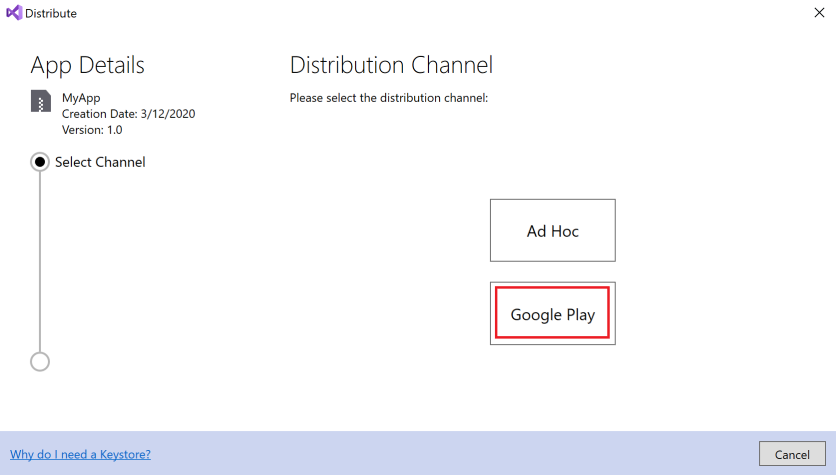
In the Signing Identity dialog, select the identity created in Creating a New Document and click Continue:

In the Google Play Accounts dialog, click the + button to add a new Google Play Account:
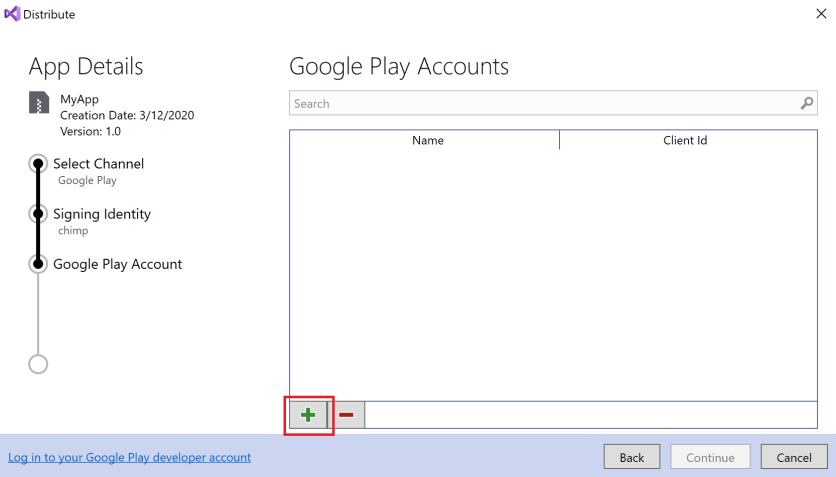
In the Annals Google API Access dialog, you must provide the Client ID and Client secret that provides API access to your Google Play Developer account:

The next section explains how to create a new Google API projection and generate the needed Client ID and Client secret.
Create a Google API Project
First, sign into your Google Play Developer account. If yous practise non already take a Google Play Developer business relationship, run into Get Started with Publishing. As well, the Google Play Developer API Getting Started explains how to use the Google Play Developer API. Afterwards you lot sign into the Google Play Developer Console, click CREATE Application:

After creating the new project, it volition be linked to your Google Play Developer Console business relationship.
The adjacent footstep is to create an OAuth Client for the app (if one has not already been created). When users request access to their private data using your app, your OAuth Client ID is used to authenticate your app.
Go to the Settings page.

In the Settings page, select API access and click CREATE OAUTH CLIENT to create a new OAuth customer:
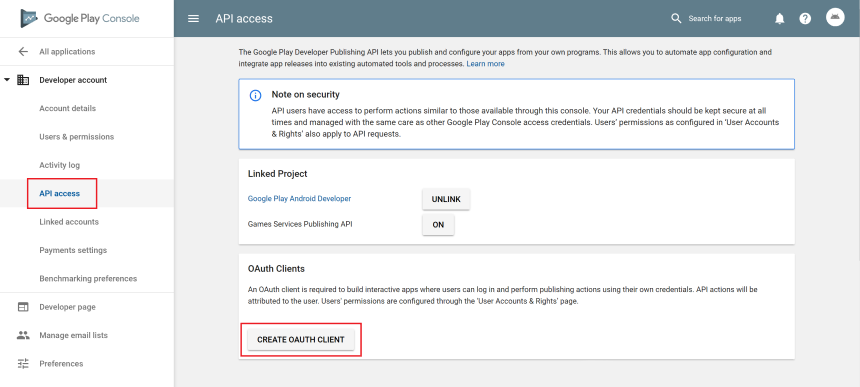
After a few seconds, a new Client ID is generated. Click View in Google Developers Panel to see your new Client ID in the Google Developer'due south Console:
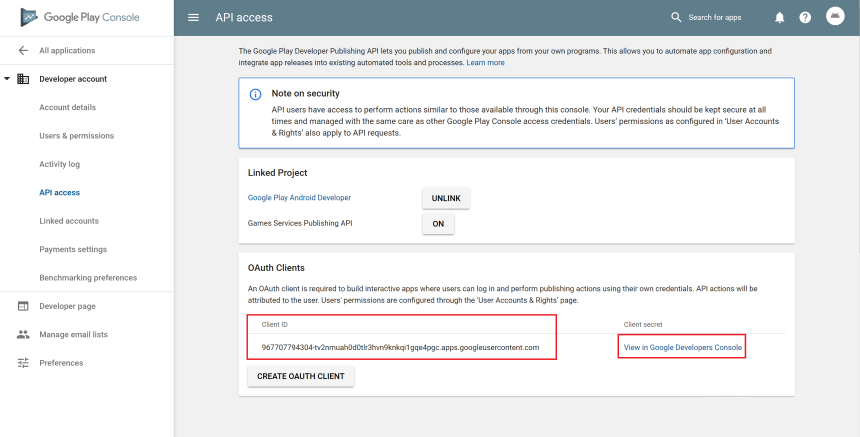
The Customer ID is displayed forth its name and creation date. Click the Edit OAuth Client icon to view the Client hush-hush for your app:

The default name of the OAuth customer is Google Play Android Developer. This can be changed to the name of Xamarin.Android app, or any suitable proper noun. In this example, the OAuth Client name is changed to the name of the app, MyApp:

Click Save to salve changes. This returns to the Credentials page where to download the credentials past clicking on the Download JSON icon:

This JSON file contains the Client ID and Customer secret that you can cutting and paste into the Sign and Distribute dialog in the side by side step.
Register Google API Access
- Visual Studio
- Visual Studio for Mac
Utilize the Client ID and Customer secret to complete the Google Play API Business relationship dialog in Visual Studio for Mac. It is possible to give the account a description – this makes information technology possible to register more than one Google Play account and upload future APK's to different Google Play accounts. Re-create the Client ID and Client hugger-mugger to this dialog and click Annals:

A web browser will open and prompt you to sign into your Google Play Android Programmer account (if you lot are not already signed in). After you sign in, the following prompt is displayed in the web browser. Click Let to qualify the app:
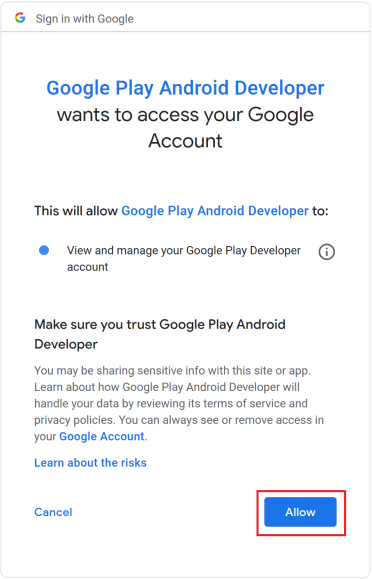
Publish
After clicking Allow, the browser reports Received verification code. Closing... and the app is added to the list of Google Play Accounts in Visual Studio. In the Google Play Accounts dialog, click Continue:
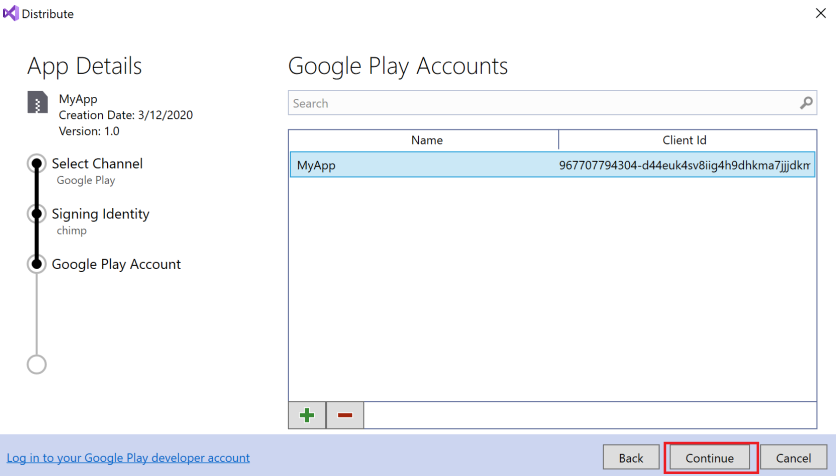
Next, the Google Play Runway dialog is presented. Google Play offers five possible tracks for uploading your app:
- Internal – Used for speedily distributing your app for internal testing and quality assurance checks.
- Blastoff – Used for uploading an early version of your app to a small list of testers.
- Beta – Used for uploading an early version of your app to a larger list of testers.
- Product – Used for full distribution to the Google Play store.
- Custom – Used for testing pre-release versions of your app with specific users past creating a listing of testers past email accost.
Choose which Google Play rails will exist used for uploading the app and click Upload.
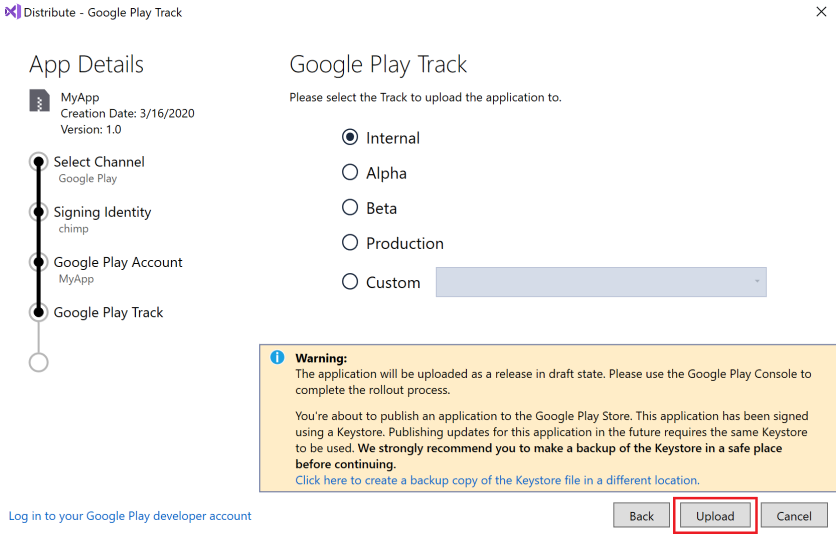
For more information about Google Play testing, see Fix open/closed/internal tests.
Next, a dialog is presented to enter the password for the signing document. Enter the countersign and click OK:

The Archive Manager displays the progress of the upload:
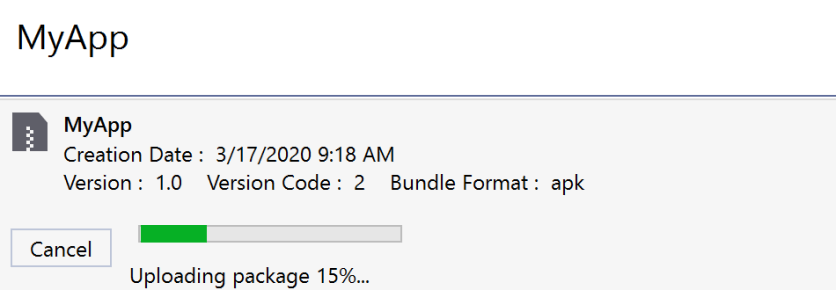
When the upload finishes, completion condition is shown in the lower left paw corner of Visual Studio:

Troubleshooting
If you do not run across your custom track when selecting a Google Play track, make sure you have created a release for that track on the Google Play Developer Panel. For instructions on how to create a release, see Prepare & whorl out releases.
Notation that one APK must accept already been submitted to the Google Play store before the Publish to Google Play volition work. If an APK is not already uploaded the Publishing Wizard will brandish the following fault in the Errors pane:

When this mistake occurs, manually upload an APK (such as an Ad Hoc build) via the Google Play Developer Console and use the Distribution Aqueduct dialog for subsequent APK updates. For more than information, see Manually Uploading the APK. The version code of the APK must change with each upload, otherwise the following fault volition occur:

To resolve this fault, rebuild the app with a unlike version number and resubmit it to Google Play via the Distribution Channel dialog.
pittmanwillieret1950.blogspot.com
Source: https://docs.microsoft.com/en-us/xamarin/android/deploy-test/publishing/publishing-to-google-play/
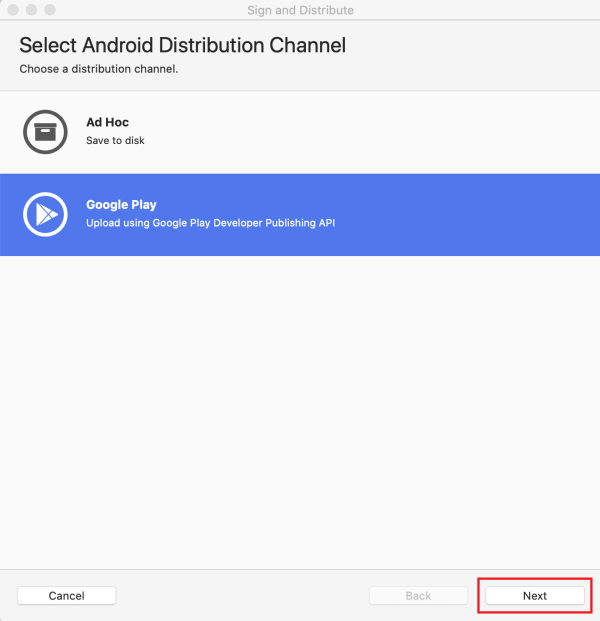
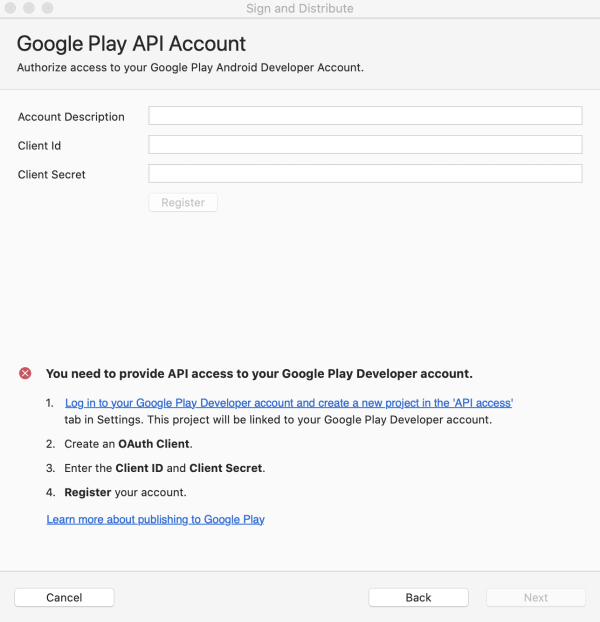

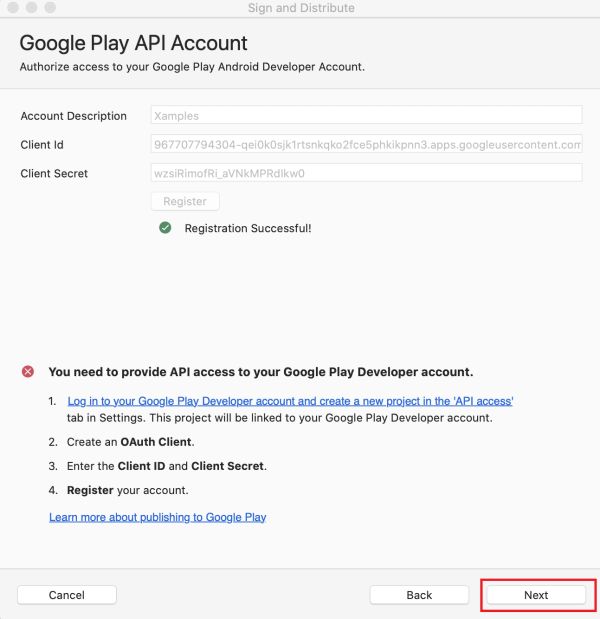
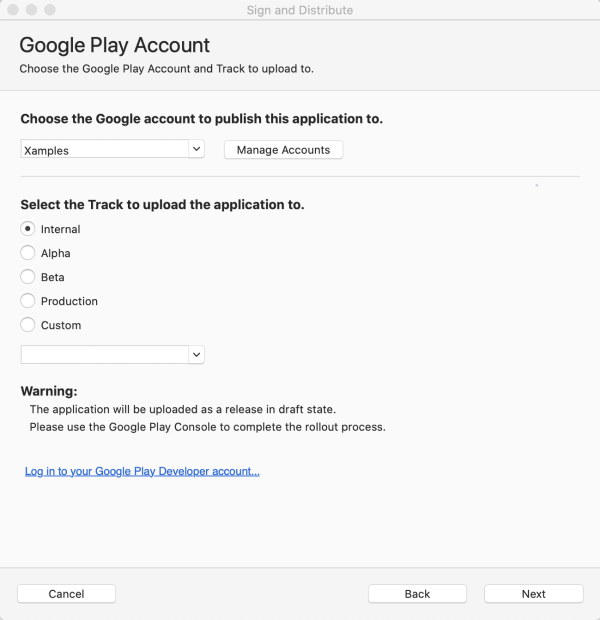
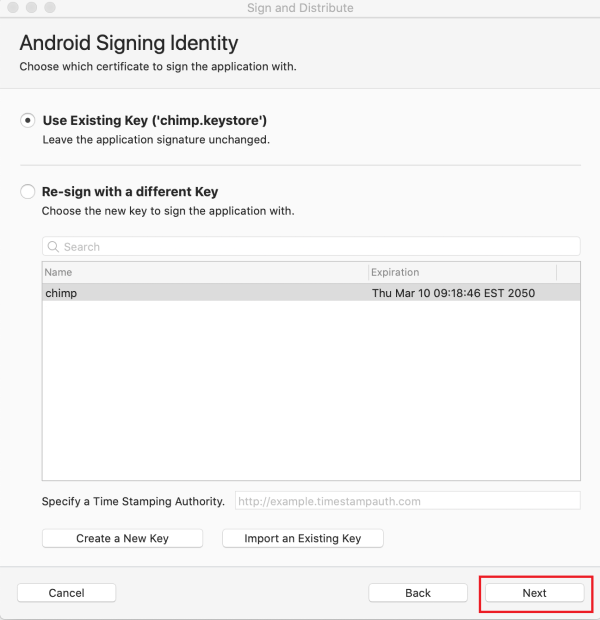

0 Response to "Google Play Upload App Restrict to Phones"
Post a Comment